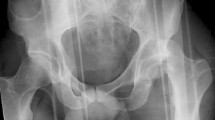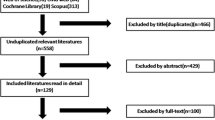Abstract
Heterotopic ossification (HO) and avascular necrosis (AVN) have been identified as post-traumatic complications of femoral head fractures and may lead to a restriction in hip function and permanent disability. The question of which surgical approach is the best for the femoral head fracture and its relationship with HO and AVN remains controversial. We conducted a systematic review in which all published studies were evaluated. We performed a literature search in MEDLINE, PubMed, EMBASE, MD Consult, and the Cochrane Controlled Trial Register from 1980 to April 2009. We found ten appropriate studies, describing 176 patients. A lower percentage of patients treated with a trochanteric flip approach was reported with HO than patients treated with anterior or posterior approach (33.3% versus 42.1% and 36.9%, respectively), although the difference was not statistically significant. The incidence of AVN was highest in the posterior approach group (16.9%), and subsequently with the trochanteric flip approach (12.5%) and the anterior group (7.9%). The investigators concluded that the use of the anterior approach may result in a higher risk for HO and the posterior approach may result in a higher risk for AVN. A new, posterior-based approach of trochanteric flip seems to be a better approach for femoral head fractures. A further case-control study would be appropriate to confirm the findings in our systematic review.
Similar content being viewed by others
References
Asghar FA, Karunakar MA (2004) Femoral head fractures: diagnosis, management, and complications. Orthop Clin Norh Am 35:463–472
Birkett J (1869) Description of a dislocation of the head of the femur complicated with its fracture, with remarks. Med Chir Trans, London 53:133
Blokhuis TJ, Frolke JP (2009) Is radiation superior to indomethacin to prevent heterotopic ossification in acetabular fractures? Clin Orthop Relat Res 467:526–530
Butler JE (1981) Pipkin type-II fractures of the femoral head. J Bone Jt Surg Am 63:1292–1296
Epstein HC, Wiss DA, Cozen L (1985) Posterior fracture dislocation of the hip with fractures of the femoral head. Clin Orthop Relat Res 201:9–17
Henle P, Kloen P, Siebenrock KA (2007) Femoral head injuries: which treatment strategy can be recommended? Injury 38:478–488
Kloen P, Siebenrock KA, Raaymakers EL, Marti RK, Ganz R (2002) Femoral head fractures revisited. Euro J Trauma 4:221–233
Marchetti ME, Steinberg GG, Coumas JM (1996) Intermediate-term experience of Pipkin fracture-dislocations of the hip. J Ortho Trauma 10:455–461
Mostafa MM (2001) Femoral head fractures. Int Orthop 25:51–54
Pakos EE, Pitouli EJ, Tsekeris PG, Papathanasopoulou V, Stafilas K, Xenakis TH (2006) Prevention of heterotopic ossification in high-risk patients with total hip arthroplasty: the experience of a combined therapeutic protocol. Int Orthop 30:79–83
Prokop A, Helling HJ, Hahn U, Udomkaewkanjana C, Rehm KE (2005) Biodegradable implants for Pipkin fractures. Clin Orthop Relat Res 432:226–233
Stannard JP, Harris HW, Volgas DA, Alonso JE (2000) Functional outcome of patients with femoral head fractures associated with hip dislocations. Clin Orthop Relat Res 377:44–56
Steffen R, O’Rourke K, Gill HS, Murray DW (2007) The anterolateral approach leads to less disruption of the femoral head-neck blood supply than the posterior approach during hip resurfacing. J Bone Jt Surg Br 89:1293–1298
Steffen RT, Fern D, Norton M, Murray DW, Gill HS (2009) Femoral oxygenation during hip resurfacing through the trochanteric flip approach. Clin Orthop Relat Res 467:934–939
Solberg BD, Moon CN, Franco DP (2009) Use of trochanteric flip osteotomy improves outcomes in Pipkin IV fractures. Clin Orthop Relat Res 467:929–933
Swiontkowski MF, Thorpe M, Seiler JG, Hansen ST (1992) Operative management of displaced femoral head fractures: case-matched comparison of anterior versus posterior approached for Pipkin I and Pipkin II fractures. J Orthop Trauma 6(4):437–442
Vermeiren JA, Hoye MV (1991) Three cases of femoral head fracture in a single car accident. J Trauma 31:579–581
Wright RW, Kuhn JE, Amendola A, Jones MH, Spindler KP (2007) Integrating evidence-based medicine into clinical practice. J Bone Jt Surg Am 89:199–205
Author information
Authors and Affiliations
Corresponding author
Rights and permissions
About this article
Cite this article
Guo, J.J., Tang, N., Yang, H.L. et al. Impact of surgical approach on postoperative heterotopic ossification and avascular necrosis in femoral head fractures: a systematic review. International Orthopaedics (SICOT) 34, 319–322 (2010). https://doi.org/10.1007/s00264-009-0849-3
Received:
Revised:
Accepted:
Published:
Issue Date:
DOI: https://doi.org/10.1007/s00264-009-0849-3




